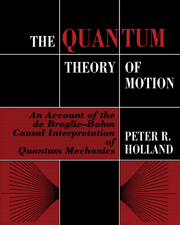 The Quantum Theory of Motion
The Quantum Theory of Motion Book contents
- Frontmatter
- Contents
- Preface
- 1 Quantum mechanics and its interpretation
- 2 Hamilton–Jacobi theory
- 3 Elements of the quantum theory of motion
- 4 Simple applications
- 5 Interference and tunnelling
- 6 The classical limit
- 7 Many-body systems
- 8 Theory of experiments
- 9 Spin ½: the Pauli theory
- 10 Spin ½: the rigid rotator
- 11 The Einstein–Podolsky–Rosen experiment and nonlocality
- 12 Relativistic quantum theory
- References
- Index
3 - Elements of the quantum theory of motion
Published online by Cambridge University Press: 20 January 2010
- Frontmatter
- Contents
- Preface
- 1 Quantum mechanics and its interpretation
- 2 Hamilton–Jacobi theory
- 3 Elements of the quantum theory of motion
- 4 Simple applications
- 5 Interference and tunnelling
- 6 The classical limit
- 7 Many-body systems
- 8 Theory of experiments
- 9 Spin ½: the Pauli theory
- 10 Spin ½: the rigid rotator
- 11 The Einstein–Podolsky–Rosen experiment and nonlocality
- 12 Relativistic quantum theory
- References
- Index
Summary
The basic postulates
The statistical interpretation of the wavefunction is in accord with experimental facts. An interference pattern on a screen is built up by a series of apparently random events, and the wavefunction correctly predicts where the particle is most likely to land over an ensemble of trials (cf. the frontispiece). Yet the interpretation of the wavefunction which ascribes to it a purely statistical significance is not forced on us by the experimental results – the latter show only that it is consistent to regard the wavefunction as containing information on probability; they do not exclude the possibility that it may possess other properties. On the contrary, one may take the view that the characteristic distribution of spots on a screen which build up an interference pattern is evidence that the wavefunction indeed has a more potent physical role than a mere repository of information on probabilities, for how are the particles guided so that statistically they fall into such a pattern? Such a question is naturally ruled out by the purely probabilistic interpretation. But the latter is appropriate only if we wish to reduce physics to a kind of algorithm which is efficient at correlating the statistical results of experiments. If we wish to do more, and attempt to understand the experimental results as the outcome of a causally connected series of individual processes, then we are free to enquire as to the possible further significance of the wavefunction (beyond its probabilistic aspect), and to introduce other concepts in addition to the wavefunction.
Information
- Type
- Chapter
- Information
- The Quantum Theory of MotionAn Account of the de Broglie-Bohm Causal Interpretation of Quantum Mechanics, pp. 66 - 135Publisher: Cambridge University PressPrint publication year: 1993
Accessibility standard: Unknown
Why this information is here
This section outlines the accessibility features of this content - including support for screen readers, full keyboard navigation and high-contrast display options. This may not be relevant for you.Accessibility Information
- 1
- Cited by